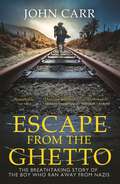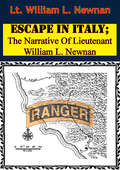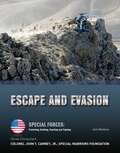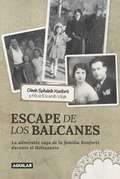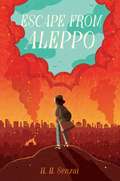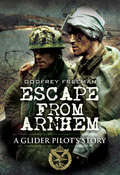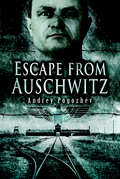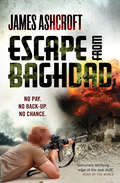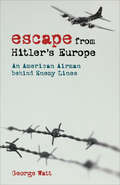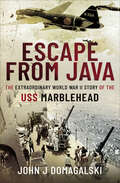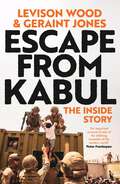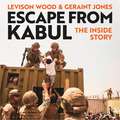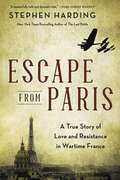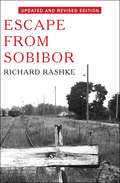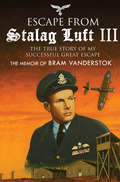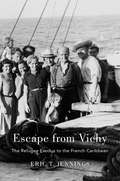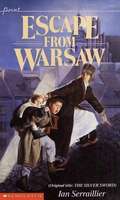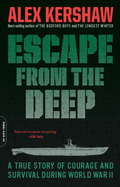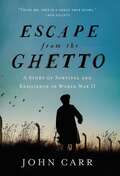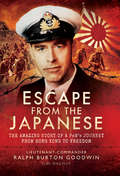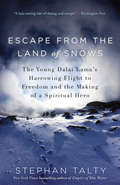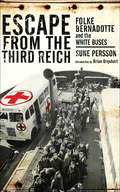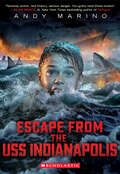- Table View
- List View
Escape From the Ghetto: The Breathtaking Story of the Jewish Boy Who Ran Away from the Nazis
by John Carr'Trust me, this is a great true story' - Ken Follett 'It deserves to be ranked among the great survival stories of the Second World War' - The Jewish Chronicle ~~~~~ The captivating true story of one boy's flight across Europe to escape the Nazis. A tale of extraordinary courage, incredible adventure, and the relentless pursuit of life in the face of impossible challenges. In early 1940 Chaim Herszman was locked in to the Lódz Ghetto in Poland. Hungry, fearless and determined, he goes on scavenging missions outside the wire limits, until he is forced to kill a Nazi guard. That moment changes the course of his life, and sets him on an unbelievable adventure across enemy lines. Chaim avoids grenade and rifle fire on the Russian border, shelters with a German family in Berlin, falls in love in occupied France, is captured on a mountain pass in Spain, gets interrogated as a potential Nazi spy in Britain, and eventually fights for everything he believes in as part of the British Army. He protects his life by posing as an Aryan boy with a crucifix around his neck, and fights for his life through terrible and astonishing circumstances. Escape from the Ghetto is about a normal boy who faced extermination by the Nazis in the ghetto or a Nazi deathcamp, and the extraordinary life he led in avoiding that fate. It's a bittersweet story about epic hope, beauty amidst horror, and the triumph of the human spirit. John Carr is Henry Carr's eldest son, and in Escape From the Ghetto he has recreated his father's incredible adventure, through recordings and transcribed conversations in later life. For fans of The Tattooist of Auschwitz, The Saboteur of Auschwitz and The Volunteer, this is the incredible true story of escape from the Nazis during World War II. REVIEWS 'John Carr deserves our gratitude for rescuing this World War Two story, among the most dramatic and vivid I've read.' - Edward Stourton, author of Cruel Crossing 'This is an unbelievable story that is all completely true. The life described is astonishing. John Carr has done an extraordinary and riveting job uncovering the real father behind the dad he thought he knew.' - Lord Tony Hall 'Utterly Compelling. It is an extraordinary tale, brilliantly written' - Alastair Stewart 'Extraordinary.'- Fiona MacTaggart 'The remarkable story of a Jewish boy who killed a Nazi guard and escaped the Holocaust aged 13' - The Times 'Unputdownable. A gripping, life affirming story of survival against seemingly impossible odds.' - Deborah Cadbury, author of Prince at War 'This is a book you cannot put down... Passionate and spellbinding, and an absolute must read.' - Julia Neuberger "John Carr's book gives a truly riveting account of his teenage Dad's life on the run in Nazi-occupied Europe. It serves as a reminder of the cruel and arbitrary realities of the refugee experience. It won't be on Priti Patel's reading list but it should be on yours." - Jon Bloomfield "An eloquent tribute to courage and resourcefulness, Escape from the Ghetto, is a gripping page turner." - Esther Safran Foer "One of the most extraordinary books I have ever read" - Michael Dobbs, author of House of Cards
Escape In Italy; The Narrative Of Lieutenant William L. Newnan
by Lt. William L. NewnanDuring the bloody fighting of the Second World War the hills, river valleys and hellish attrition of the Italian campaign are often overlooked as a sideshow. However some of the toughest fighting and heroic actions of the entire period took place in the beautiful but deadly Italian countryside; one such tale is that of Lt. Newnan. Then as now, the Army Rangers get the toughest assignments, Lt. Newnan and his men were tasked with attacking Cisterna during the Anzio campaign. The elite, but lightly armed, Rangers were ambushed by German Panzer forces, outnumbered and outgunned many Rangers were captured including the author. Not one to be so easily defeated Lt. Newnan began an epic journey of escape and evasion in Nazi infested Italy which he recounts in this vivid and colorful memoir.
Escape and Evasion (Special Forces: Protecting, Building, Te)
by Jack MontanaOperating behind enemy lines takes nerve, courage, and skill. Above all, it requires the knowledge of how to stay undetected and how to escape if need be. These are the lessons of Escape and Evasion. The book covers all the essential skills of an undercover soldier. Infiltration by land, sea, and air are described in detail. The unique physical demands of night fighting are explained. Tracking techniques are also revealed, showing how the elite soldier can tell where the enemy is from broken twigs and dropped litter. In addition, this book explains some of the most surprising features of behind-the-lines operations, including: * How you can fool a tracker dog * Why you should look at the outline of shapes at night. * How you can calculate the distance of an enemy from a gunshot. * Why you should put bits of tape on all metal objects you carry. * What the best place is for an ambush.
Escape de los Balcanes: La admirable saga de la familia Konforti durante el Holocausto
by Dinah Spitalnik Alicia EscardóRecreada con la intensidad de una novela, esta asombrosa crónica está bordada de aromas, sabores y costumbres que acompañan a esta familia en su peripecia entre la guerra y la dignidad humana. Dos mujeres narran como en torrente aquellos años de incertidumbres y miedo. Una menciona truenos en la noche. La otra le dice que eran disparos de metralleta. Hablan de aquella familia musulmana que los auxilió, del peso de las monedas cosidas en la ropa interior y del aire gélido de las montañas que debieron atravesar para escapar. Pasaron más de setenta años del holocausto en los Balcanes y Dinah escucha asombrada esta conversación entre su madre y tía abuela. Empieza a entender tantas cosas, a unir recuerdos, a evocar el aroma de las recetas de la abuela y comprender que fueron su silenciosa forma de rememorar# Tiempo después, un inesperado correo disparará definitivamente su búsqueda, con el objetivo de completar el legado. Escape de los Balcanes recoge el viaje de descubrimiento que emprende Dinah por Macedonia, Kosovo y Albania, rutas por las que su familia deambuló para sobrevivir, y las vivencias de los Konforti entre 1940 y 1944, cuando empiezan las persecuciones a los judíos. Recreada con la intensidad de una novela, esta asombrosa crónica está bordada de aromas, sabores y costumbres que acompañan a esta familia en su peripecia entre la guerra y la dignidad humana.
Escape from Aleppo
by N. H. SenzaiAn Indie Next List Pick <p><p> Nadia’s family is forced to flee their home in Aleppo, Syria, when the Arab Spring sparks a civil war in this timely coming-of-age novel from award-winning author N.H. Senzai.Silver and gold balloons. <p><i>A birthday cake covered in pink roses. A new dress. </i> <p>Nadia stands at the center of attention in her parents’ elegant dining room. This is the best day of my life, she thinks. Everyone is about to sing “Happy Birthday,” when her uncle calls from the living room, “Baba, brothers, you need to see this.” Reluctantly, she follows her family into the other room. On TV, a reporter stands near an overturned vegetable cart on a dusty street. Beside it is a mound of smoldering ashes. The reporter explains that a vegetable vendor in the city of Tunis burned himself alive, protesting corrupt government officials who have been harassing his business. Nadia frowns. <p> It is December 17, 2010: Nadia’s twelfth birthday and the beginning of the Arab Spring. Soon anti-government protests erupt across the Middle East and, one by one, countries are thrown into turmoil. As civil war flares in Syria and bombs fall across Nadia’s home city of Aleppo, her family decides to flee to safety. Inspired by current events, this novel sheds light on the complicated situation in Syria that has led to an international refugee crisis, and tells the story of one girl’s journey to safety.
Escape from Arnhem: A Glider Pilot’s Story
by Godfrey FreemanThis is the remarkable true story of a young army glider pilots experience of the last days in the defense of Arnhem Bridge, his eventual capture and then escape to be adopted by the Resistance, the hair-raising journey through occupied Europe and his eventual return to the UK. After capture Freeman was first taken to Apeldoorn where he was hospitalized, claiming shell-shock. Although quite sane, he feigned trauma with escape in mind, until being punished for aiding the escape of four Allied inmates. Then he was put on a train bound for Germany, from this he escaped and eventually made contact with the Dutch underground. He is given civilian cloths and a bicycle and rides overnight to Barnveld where he stays with a schoolmaster and church organist. Then another cycle ride to a farm where he sleeps in the hayloft and finally still on his bike, he rides through the German front lines. He eventually is returned to RAF Broadwell by Dakota to resume his part in the war, from capture to freedom within a month. The text is interspersed with flashbacks to the authors childhood and early training, capturing the true spirit of a typical modest and yet outstandingly brave young man of the wartime era.
Escape from Auschwitz
by Andrey PogozhevThis memoir of a Soviet POW&’s escape from a Nazi concentration camp is a remarkable account of cruelty and courage during WWII. On November 6, 1942, seventy Soviet prisoners of war staged an extraordinary mass escape from Auschwitz. Among the escapees was prisoner number 1418, Andrey Pogozhev. One of the few who managed to evade the pursuing Nazi guards, Pogozhev lived to tell his story in this singular chronicle of wartime survival. Pogozhev was caught by the Germans in 1941 and immediately sent to Auschwitz. He and his Red Army comrades were then put to work on the Birkenau construction site. Sick, starving, and forced to work in sub-zero weather, more than three hundred Russian prisoners died in a single day. Pogohzev vividly recounts what life was like inside Auschwitz, how a group of prisoners managed to organize and execute one of the few successful escapes from Auschwitz, and his punishing journey as a fugitive fleeing through the Carpathian Mountains into the Ukraine.
Escape from Baghdad: First Time Was For the Money, This Time It's Personal
by James AshcroftGun-for-hire James 'Ash' Ashcroft thought he'd left Iraq behind. Last time he only got out alive thanks to the bravery of his interpreter and friend Sammy. But now a call for help means Ash must once again face the chaos of war-torn Baghdad - and this time there's no pay cheque. Abandoned by the occupying Coalition Forces, Sammy and his family face certain death at the hands of the Shia-dominated Iraqi Police and the death squads that roam the streets unless Ash and his team can get in and get them to safety over the border. This is the action-packed story of their audacious escape from Baghdad. It is a gripping account of the chaos of war, where the only thing that can be relied upon is the bond between former brothers-in-arms.
Escape from Hitler's Europe: An American Airman behind Enemy Lines
by George Watt&“An absorbing story about how the Lincoln veteran George Watt managed to escape from Nazi-occupied Belgium.&”—San Francisco Review of Books November 1943: American flyer George Watt parachutes out of his burning warplane and lands in rural Nazi-occupied Belgium. Escape from Hitler&’s Europe is the incredible story of his getaway—how brave villagers spirited him to Brussels to connect with the Comet Line, a rescue arm of the Belgian resistance. This was a gravely dangerous mission, especially for a Jewish soldier who had fought against Franco in the Spanish Civil War. Watt recounts dodging the Gestapo, entering Paris via the underground, and finally, crossing the treacherous Pyrenees into Spain. In 1985, he returned to Belgium and discovered an astonishing postscript to his wartime experiences. &“A story of what is best in human beings triumphing over what is worst.&”—John Sayles, author of Yellow Earth &“One of those rare little narratives that engage the reader from the first page to the last . . . It is about the human spirit and those willing to risk their lives for a stranger.&”—Library Journal "A hell of an adventure story."―Ring Lardner, Jr., author of The Ecstasy of Owen Muir &“This is one of my favorite books about World War II, and the first I have read that is about the Comet Line and the people who helped with running it.&”—Armchair Interviews &“This is an interesting and exciting account that provides a first-person examination of the plight of an individual airman, and insights into the scope, risks, and techniques of the Belgian and French underground movements.&”—Col. Stetson M. Siler, USAF (Ret.)
Escape from Java: The Extraordinary World War II Story of the USS Marblehead
by John J. DomagalskiThe harrowing, triumphant true story of an antiquated light cruiser and its crew suddenly under fire in the Pacific as WWII erupted: &“An engrossing tale.&” —Naval Historical Foundation The old light cruiser Marblehead was living out her final years of naval service as a member of the United States Asiatic Fleet in 1941. The small group of mostly antiquated ships based in the Philippines sailed the waters of East Asia to show the American flag in places like China, Hong Kong, Japan, and Singapore. Then the sudden eruption of World War II in the Pacific put the warship on the front lines of the conflict as Imperial Japan unleased a series of devastating attacks across the region. On the morning of February 4, 1942, the warship was surprised by Japanese planes northeast of Java. Two large bombs slammed into Marblehead, causing fires and casualties and knocking out her steering gear. A third bomb exploded close by underwater. The near miss ripped a large gash into her hull, allowing a torrent of water to rush inside the ship. Escape from Java takes us throughout the ship as the story unfolds—next to gunners toiling to keep their guns firing, with medical staff tending to the wounded, and alongside damage control sailors working in flooded compartments. The Japanese confidently radioed that they had sunk the ship—but through courage, sacrifice, and superhuman effort, Marblehead would set out on a harrowing 13,000-mile journey back to the US . . . &“An engrossing tale of an obsolescent ship&’s survival amid great odds set against the brutal early fighting of the Pacific War. This book will appeal to a wide audience not only as high wartime adventure but simply as a story of gritty perseverance when the odds are heavily against.&” —Naval Historical Foundation
Escape from Kabul: The Inside Story
by Levison Wood Geraint Jones'An important account of one of the defining moments of the modern world' PETER FRANKOPANThe evacuation of Kabul in August 2021 will go down in military history as one of the most unexpected events in modern times. In an eerie replay of the disastrous British retreat from Kabul in 1842, coalition troops withdrew from Afghanistan after twenty years of military campaigning. The subsequent collapse of the Afghan government and its army shocked the world, as a resurgent Taliban gathered its forces and swept across the country. Thousands of Afghans who had worked with the allies were left to the meagre mercy of the Taliban.As the Taliban went door to door to execute 'collaborators', a small international task force set out on a daring mission to evacuate as many Afghans and their families as possible.Drawing on a wide range of first-hand accounts - the politicians and officers who planned the trans-continental rescue, the young soldiers who were faced with the unenviable task of keeping a crowd of thousands of desperate people at bay, former interpreters and soldiers of the Afghan Special Forces who made it out - Escape from Kabul is the harrowing true story of Operation Pitting and the Kabul airlift.
Escape from Kabul: The Inside Story
by Levison Wood Geraint Jones'An important account of one of the defining moments of the modern world' PETER FRANKOPANThe evacuation of Kabul in August 2021 will go down in military history as one of the most unexpected events in modern times. In an eerie replay of the disastrous British retreat from Kabul in 1842, coalition troops withdrew from Afghanistan after twenty years of military campaigning. The subsequent collapse of the Afghan government and its army shocked the world, as a resurgent Taliban gathered its forces and swept across the country. Thousands of Afghans who had worked with the allies were left to the meagre mercy of the Taliban.As the Taliban went door to door to execute 'collaborators', a small international task force set out on a daring mission to evacuate as many Afghans and their families as possible.Drawing on a wide range of first-hand accounts - the politicians and officers who planned the trans-continental rescue, the young soldiers who were faced with the unenviable task of keeping a crowd of thousands of desperate people at bay, former interpreters and soldiers of the Afghan Special Forces who made it out - Escape from Kabul is the harrowing true story of Operation Pitting and the Kabul airlift.
Escape from Kabul: The Inside Story
by Levison Wood Geraint JonesAfghanistan, August 2021. As the clock ticks down to a total Allied withdrawal and the Taliban go door to door to execute 'collaborators', a small, semi-official force of allied Paratroopers and Marines set about evacuating as many Afghans and their families as possible.The evacuation of Kabul in August 2021 will go down in military history as one of the most unexpected events in modern times. In an eerie replay of the disastrous British retreat from Kabul in 1842, coalition troops withdrew from Afghanistan after 20 years of military campaigning. The subsequent collapse of the Afghan governmentand its army shocked the world, as a resurgent Taliban gathered its forces and swept across the country. Thousands of Afghans who had worked with the allies were left to the meagre mercy of the Taliban.As the Taliban went door to door to execute 'collaborators', a small international task force set out on a daring mission to evacuate as many Afghans and their families as possible.Drawing on a wide range of first-hand accounts - the politicians and officers who planned the trans-continental rescue, the young soldiers who were faced with the unenviable task of keeping a crowd of thousands of desperate people at bay, former interpreters and soldiers of the Afghan Special Forces who made it out - Escape from Kabul is the harrowing true story of Operation Pitting and the Kabul airlift.(P) 2023 Hodder & Stoughton Limited
Escape from Paris: A True Story of Love and Resistance in Wartime France
by Stephen HardingThis book is The Nightingale meets All the Light We Cannot See, only it's all true--a thrilling wartime adventure story of downed American aviators rescued by French resistance fighters, taken to Nazi-occupied Paris, and hidden under the very noses of the GestapoEscape from Paris is the true story of a small group of U.S. aviators whose four B-17 Flying Fortresses were shot down over German-occupied France on a single, fateful day: July 14, 1943, Bastille Day. They were rescued by brave French civilians and taken to Paris for eventual escape out of France. In the French capital, where German troops walked on every street and Gestapo agents hid around every corner, the flyers met a brave Parisian resistance family living and working in the Hôtel des Invalides, a complex of buildings and military memorials, where Nazi officials had set up offices. Hidden in the complex the Americans, along with dozens of other downed Allied pilots and resistance operatives, hatched daring escape plots. The danger of discovery by the Nazis grew every day, as did an unlikely romance when one of the American airmen begins a star-crossed wartime romance with the twenty-two-year old daughter of the family sheltering him--a noir tale of war, courage and desperation in the shadows of the City of Light.Based on official American, French, and German documents, histories, personal memoirs, and the author's interviews with several of the story's key participants, Escape from Paris crosses the traditional lines of World War II history with tense drama of air combat over Europe, the intrigue of occupied Paris, and courageous American and Allied pilots and French resistance fighters pitted against Nazi thugs. All of this set in one of the world's most beautiful and captivating cities.
Escape from Sobibor: Revised And Updated Edition
by Richard RashkeThis true story of a revolt at a Nazi death camp, newly updated, is &“a memorable and moving saga, full of anger and anguish, a reminder never to forget&” (San Francisco Chronicle). On October 14, 1943, six hundred Jews imprisoned in Sobibor, a secret Nazi death camp in eastern Poland, revolted. They killed a dozen SS officers and guards, trampled the barbed wire fences, and raced across an open field filled with anti-tank mines. Against all odds, more than three hundred made it safely into the woods. Fifty of those men and women managed to survive the rest of the war. In this edition of Escape from Sobibor, fully updated in 2012, Richard Rashke tells their stories, based on his interviews with eighteen of the survivors. It vividly describes the biggest prisoner escape of World War II. A story of unimaginable cruelty. A story of courage and a fierce desire to live and to tell the world what truly went on behind those barbed wire fences.
Escape from Stalag Luft III: The True Story of My Successful Great Escape: The Memoir of Bob Vanderstok
by Simon Pearson Bram VanderstokA memoir of the most decorated pilot in Dutch history and one of the World War II POWs who fled Nazi Germany what is known as &“The Great Escape.&” On the night of 24 March 1944, Bram Vanderstok was the eighteenth of 76 men who crawled out of Stalag Luft III in Zagan, Poland. The 1963 film The Great Escape was largely based on this autobiography but—with Vanderstok's agreement—filmmakers chose to turn his story into an Australian character named Sedgwick, played by James Coburn. His memoir sets down his wartime adventures before being incarcerated in Stalag Luft III and then describes various escape attempts which culminated with the famous March breakout. After escaping, Vanderstok roamed Europe for weeks before making it back to England. Two months after escaping, he returned to the British no. 91 Squadron. In the following months he flew almost every day to France, escorting bombers and knocking down V1 rockets. In August 1944, he finally returned to his home. He learned that his two brothers had been killed in concentration camps after being arrested for resistance work. His father had been tortured and blinded by the Gestapo during interrogation. He had never betrayed his son. &“His escapes, his operations as a Spitfire pilot, his experiences as a prisoner of war, and his incredible escape crossing the Pyrenees—all are described in a breathtaking manner which made me read his book through in one sitting.&” —Prof. Dr. L de Jong, founder/director of the Dutch Institute for War Documentation &“Such a modest man, such a dramatic story—you&’ll be pulled into this absorbing account.&” —Jonathan Vance, author of The True Story of the Great Escape
Escape from Stalag Luft III: The True Story of My Successful Great Escape: The Memoir of Bob Vanderstok
by Simon Pearson Bram VanderstokA memoir of the most decorated pilot in Dutch history and one of the World War II POWs who fled Nazi Germany what is known as &“The Great Escape.&” On the night of 24 March 1944, Bram Vanderstok was the eighteenth of 76 men who crawled out of Stalag Luft III in Zagan, Poland. The 1963 film The Great Escape was largely based on this autobiography but—with Vanderstok's agreement—filmmakers chose to turn his story into an Australian character named Sedgwick, played by James Coburn. His memoir sets down his wartime adventures before being incarcerated in Stalag Luft III and then describes various escape attempts which culminated with the famous March breakout. After escaping, Vanderstok roamed Europe for weeks before making it back to England. Two months after escaping, he returned to the British no. 91 Squadron. In the following months he flew almost every day to France, escorting bombers and knocking down V1 rockets. In August 1944, he finally returned to his home. He learned that his two brothers had been killed in concentration camps after being arrested for resistance work. His father had been tortured and blinded by the Gestapo during interrogation. He had never betrayed his son. &“His escapes, his operations as a Spitfire pilot, his experiences as a prisoner of war, and his incredible escape crossing the Pyrenees—all are described in a breathtaking manner which made me read his book through in one sitting.&” —Prof. Dr. L de Jong, founder/director of the Dutch Institute for War Documentation &“Such a modest man, such a dramatic story—you&’ll be pulled into this absorbing account.&” —Jonathan Vance, author of The True Story of the Great Escape
Escape from Vichy: The Refugee Exodus to the French Caribbean
by Eric T. JenningsIn the early years of World War II, thousands of political refugees traveled from France to Vichy-controlled Martinique in the French Caribbean, en route to what they hoped would be safer shores in North, Central, and South America. While awaiting transfer from the colony, the exiles formed influential ties—with one another and with local black dissidents. Escape from Vichy recounts this flight from the refugees’ perspectives, using novels, unpublished diaries, archives, memoirs, artwork, and other materials to explore the unlikely encounters that fueled an anti-fascist artistic and intellectual movement. The refugees included Spanish Republicans, anti-Nazi Germans and Austrians, anti-fascist Italians, Jews from across Europe, and others fleeing violence and repression. They were met with hostility by the Vichy government and rejection by the nations where they hoped to settle. Martinique, however, provided a site propitious for creative ferment, where the revolutionary Victor Serge conversed with the anthropologist Claude Lévi-Strauss, and the Surrealist André Breton met Negritude thinkers René Ménil and Aimé and Suzanne Césaire. As Eric T. Jennings shows, these interactions gave rise to a rich current of thought celebrating blackness and rejecting racism. What began as expulsion became a kind of rescue, cut short by Washington’s fears that wolves might be posing in sheep’s clothing.
Escape from Warsaw
by Ian SerraillierHistorical fiction. In Warsaw in 1942, the Balicki chidren watch in horror as Nazi Storm Troopers arrest their mother. With the war raging around them, they live in constant fear.
Escape from the Deep: A True Story of Courage and Survival During World War II
by Alex KershawEscape from the Deep
Escape from the Ghetto: A Story of Survival and Resilience in World War II
by John CarrThis captivating true story of one boy's flight across Europe to escape the Nazis is a tale of extraordinary courage, incredible adventure, and the relentless pursuit of freedom in the face of insurmountable challenges.In early 1940 Chaim Herszman was locked in to the Lódz Ghetto in Poland. Hungry, fearless, and determined, Chaim goes on scavenging missions outside the wire fence—where one day he is forced to kill a Nazi guard to protect his secret. That moment changes the course of his life and sets him on an unbelievable adventure across enemy lines. Chaim avoids grenade and rifle fire on the Russian border, shelters with a German family in the Rhineland, falls in love in occupied France, is captured on a mountain pass in Spain, gets interrogated as a potential Nazi spy in Britain, and eventually fights for everything he believes in as part of the British Army. He protects his life by posing as an Aryan boy with a crucifix around his neck, and fights for his life through terrible and astonishing circumstances. Escape from the Ghetto is about a normal boy who faced extermination by the Nazis in the ghetto and a Nazi deathcamp, and the extraordinary life he led in avoiding that fate. It's a bittersweet story about epic hope, beauty amidst horror, and the triumph of the human spirit.
Escape from the Japanese: The Amazing Tale of a PoWs Journey from Hong Kong to Freedom
by Ralph Burton GoodwinTrapped in the depths of Japanese-held territory, it was rare for Allied prisoners of war to attempt escape. There was little chance of making contact with anti-guerrilla or underground organisations and no possibility of Europeans blending in with the local Asian populations. Failure, and recapture, meant execution. This was what Lieutenant Commander R.B. Goodwin faced when he decided to escape from the Shamsuipo PoW Camp in Kowloon, Hong Kong in July 1944 after three years of internment.With no maps and no knowledge of the country or the language, Lieutenant Commander Goodwin set out across enemy territory and war-torn China. Because of the colour of his skin he had to travel during the hours of darkness for much of what was an 870-mile journey to reach British India. Few of his fellow prisoners gave him any chance of succeeding, yet, little more than three months later, he was being transported to the safety of Calcutta. For his daring and determination Lieutenant Commander Goodwin was awarded the Order of the British Empire.
Escape from the Land of Snows: The Young Dalai Lama's Harrowing Flight to Freedom and the Making of a Spiritual Hero
by Stephan TaltyFor the first time here is the story of the crucible that created the Dalai Lama the world knows today: the Lama's 14-day escape from Tibet to India in 1959, an awe-inspiring feat of courage and endurance that foiled Mao's plans and created the Tibetan government in exile.
Escape from the Third Reich: Folke Bernadotte and the White Buses
by Sune PerssonThe true story of a risky Swedish mission to liberate thousands of prisoners from the Nazis. The Swedish Red Cross expedition to the German concentration camps in March–April 1945 was the largest rescue effort inside Germany during WWII. Sponsored by the Swedish government and led by Count Bernadotte of Wisborg, the mission became known for its distinctive buses. Each bus was purposely painted entirely white, except for the Red Cross emblem on the side, so that they would not be mistaken for military targets. Due to the chaotic conditions during the last weeks of the war, it is impossible to say exactly how many prisoners were liberated by the expedition, but according to conservative figures, by May 4, 1945, at least 17,000 had been transported to Sweden by the so-called White Buses. Of these, some 8,000 were Danes and Norwegians, around 6,000 were Poles, and more than 2,000 were French citizens. This is the first book to tell the full story of this remarkable and hazardous operation. It also details Bernadotte&’s harrowing expedition to Ravensbrück concentration camp and his extraordinary negotiations with Heinrich Himmler, the Reichsführer-SS who was in charge of the German concentration camps, and tells how, during the course of these discussions, Himmler also made an offer of German surrender—an offer that was rejected by the Allies. Includes never before published photographs
Escape from the USS Indianapolis (Escape From)
by Andy Marino"Nonstop action, real history, serious danger. You gotta read these books!" --Alan Gratz, #1 New York Times bestselling author of RefugeeJuly, 1945The end of World War II is finally in sight. The Nazis have been defeated in Europe, and Albie hopes that means he and his brother, Joe, can get back to normal life. Or as normal as life can be following the death of their parents. But the war against Imperial Japan still rages, and when Joe's given a new assignment on the USS Indianapolis, Albie refuses to be left behind. Even if that means sneaking aboard and heading out to sea with the crew.The voyage is cramped and hot, and Joe's furious when he discovers Albie. But then torpedoes slam through the hull, and suddenly the brothers have much bigger problems: The Indianapolis is sinking.As the chaos and horror unfold, Joe and Albie manage to get off the ship before it goes under. Then the real nightmare begins. There's not enough food or water or supplies, and the days are long with the sun beating down on them, and the nights are longer, with no escape from the cold. All Albie, Joe, and the others can do is float-and hope that help gets to them before the Japanese navy returns to finish them off.But another enemy is coming, drawn by the blood in the water: sharks. And with their arrival, every moment becomes a relentless battle to survive.
